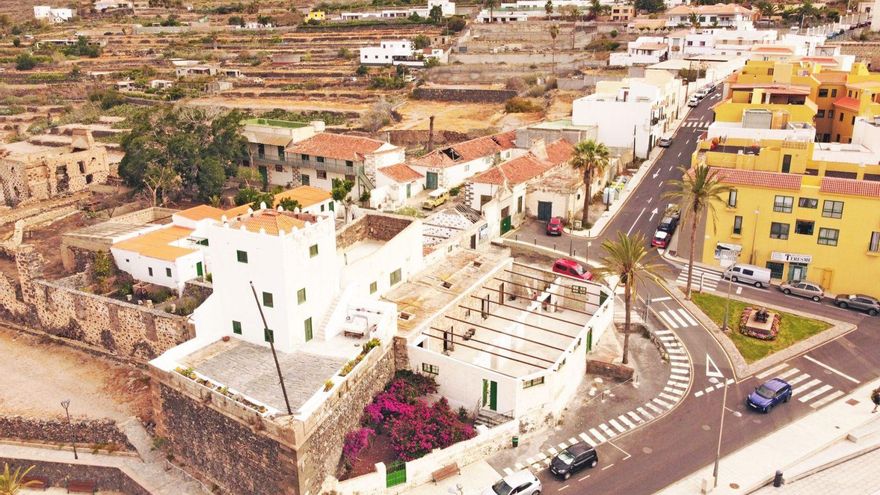
The full of Adeje Town Hall approved yesterday –with the votes in favor of PSOE and Podemos and the abstention of CC– start the expropriation file of the Casa Fuerte for its rescue due to its evident state of ruin. This property built in the mid-sixteenth century (1556, it is estimated) was declared Well of Cultural Interest (BIC), with the category of Monument, in 1986 and is located in the historic center of the municipality, in the surroundings of the Church of Santa Úrsula. The mayor, José Miguel Rodríguez Fraga, said that “it is a historic moment, we owed it to the people of Adeje. The Casa Fuerte has a very powerful symbolic load and we must rescue it to preserve it and for the enjoyment of the people».
The municipal administration launches this mechanism “in the face of the evident deterioration and state of ruin of this historic property, both due to the passage of time and due to the current conscious abandonment by the owners,” says the local government. This situation also contributes to “the actions of systematic looting and destruction” to which it has been subjected, “which include the collapse of walls and the painting of graffiti.”
The technical report warns of the need for urgent action before “the damage is irreversible” and details numerous flaws and damages in the Casa Fuerte, which include the collapse of roofs, the deterioration of construction stones or the disappearance of sgraffito and idols of great historical-artistic value. The most recent interventions, carried out with inadequate procedures and materials that patch up, distort and decontextualize the value of the monument, also contributed to devalue this complex, details the document approved yesterday by the Plenary.
The recovery of the Casa Fuerte for the town of Adeje “will be a milestone, when it is achieved, very important.” This affirmation of the authority occurs “not only because of the historical significance that this place has, because of what it meant for development and local society in good and bad times, but also because the City Council considers that a part of the future of the historical case of the municipality goes through that place and all the surroundings that make up the Plaza de España, Calle Grande, the new Theater of the Cultural Center, the Barranco del Infierno, etc.
The mayor maintains that “it is a historic moment” for the municipality due to the symbolic value of the place
Interconnection.
In this sense, the City Council has planned a semi-pedestrianization of Calle Grande. It is about promoting the permeabilization of the environment to ensure that the neighbors and transit easily between the tourist and historical areas. This communication will make it possible to publicize and value history and culture, as well as diversify the economy and generate opportunities and wealth under equal conditions for all the towns in the municipality, says the government.
The idea is to respect the original construction of the Casa Fuerte as much as possible, as established by international regulations for the preservation and restoration of heritage. In addition, the council considers that a point of tourist interest will be generated.
Decades waiting.
The City Council of Adeje resorts to the figure of forced expropriation, included in the Law of December 16, 1954, after having carried out numerous steps over the last decades to reach an amicable agreement with the owners and heirs of the property. Strong house. However, all efforts were unsuccessful as there was no unanimous agreement.
Among the damages listed is the collapse of roofs or the disappearance of sgraffito and idols
History.
In the year 1553, Pedro Ponte asked to build a fortification to defend the area from the continuous pirate incursions that devastated the coast of the municipality of Adeje. In 1555, it was authorized and in 1556 a strong house was built that became, for three centuries, the political, economic and social center of the jurisdiction of Adeje, under the stately regime of the Ponte.
Fortified residence, a mixture of a country house and a fortress, with an almost square floor plan, occupied 9,024 Castilian yards (7,200 square meters). It consisted of a castle and a keep, warehouses, barns, a stable, a blacksmith shop, a bakery, ovens, housing for servants and administrators, an oratory and a main palace. According to the French naturalist Berthelot, “the most important room is the Archives Room”, which had four large cabinets full of documents, defined by the historian Viera y Clavijo as “the Treasure of the Canary Islands”.
The Casa Fuerte, with its 466 years old, marks the history of the colonization of the southwest of Tenerife. Hacienda protected by a castle with a defensive function against the threat of pirates, it was the economic center of the area, in which agricultural and livestock economic activities were developed (with goat, bovine, mule and camel herds), as well as forest exploitation to obtain firewood, the cultivation of cereals, cane fields and horticultural products.
















